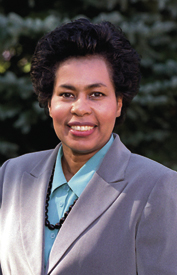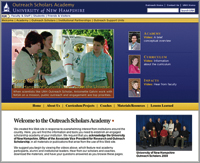Reaching Out from the Ivory Tower
LONG BEFORE the University of New Hampshire established its innovative, faculty Outreach Scholars Academy, Barry Rock was reaching out and engaging with K-12 students and teachers.
“I’ve done outreach for years because I thought it was important,” says Rock of the Complex Systems Research Center. He adds, “But while I’d get a pat on the back or an ‘attaboy’ it was never seen as anything central to what I was supposed to be doing. I remember someone saying I could do outreach as long as I did it on my own time.”
Times have changed, and UNH is now widely recognized as one of the few places where outreach is, as Rock puts it, “prized and promoted.”
Rock is one of a handful of EOS faculty who graduated from the semester-long professional development academy, which was created in 2004 and has grown into a model now being emulated by universities around the nation. Rock was a member of the inaugural class.
At its core, “outreach scholarship” is a process in which university faculty link their scholarly research to the needs of external partners to develop a mutually beneficial relationship.
In Rock’s case, the Forest Watch program, which he started in 1991 as a means of getting K-12 students involved in real scientific research, is an example of this two-way, societally relevant approach.
Rock notes that while the program’s longevity is testament to its relevance and value in the classroom, getting it off the ground was no small task. “It was a great deal of work and often a challenge getting teachers—who, I think, often see us at the university as ivory-tower egg heads—onboard.”
The Forest Watch program is a classic case of outreach enhancing research— something that Cameron Wake of the Climate Change Research Center asserts is key to outreach scholarship.
“When you address research issues with an external partner you can do so in a much more realistic and integrated way,” says Wake who, along with Eleanor Abrams (Education), Sharyn Potter (Sociology) and Lisa Townson (Cooperative Extension), collaborated with UNH Associate Vice President for Research and Outreach Scholarship Julie Williams to define the academy’s structure and goals during its start-up phase. Wake now serves as its director.
Says Williams, “Eleanor, Cameron, Sharyn and Lisa have been critically important colleagues who helped develop the academy by contributing invaluable intellectual and practical ideas. Their input and what we also learned from participants make what we now do possible.”
At a more fundamental level, George Hurtt, who also graduated from the academy, believes that science done in partnership always achieves better results. “And that’s because you bring more expertise to bear on a given problem, you have different perspectives, values, skills—people bring different back-grounds and priorities.”
The Carbon Solutions New England project (carbonsolutionsne.org) that he and Wake helped create is a perfect example of this kind of collaborative science producing societally relevant results.
“It’s outreach scholarship at a high level because the central question—how can we effectively reduce our regional carbon emissions?—is itself co-driven by scientists in collaboration with a wide range of stakeholders, and analysis is done by scientists with constant feedback from stakeholders,” says Hurtt.
To build outreach from the ground up, so to speak, and get these concepts into the classroom, Hurtt and colleagues were awarded a UNH grant through the Outreach Scholars Academy program to develop and deliver a new undergraduate inquiry course to engage freshmen in the process of outreach scholarship.
“We brought students and community partners together in teams to define and address real scientific issues in the community, and in the process influenced for the better how young students see the very relationship between science and society, Hurtt says.”
Like Rock, most faculty have engaged in some form of outreach for many years as part of the “service” faculty are expected to do—along with teaching and research. But outreach scholarship takes things a step further by instilling the two-way communication and real collaboration with external partners so that both the faculty and the partner can benefit.
Wake, Rock and others note that any discussion about successful outreach scholarship by EOS faculty would be incomplete without a tip of the hat to former EOS director Berrien Moore. Moore’s own extensive outreach scholarship throughout his career—from helping lead the International Geosphere-Biosphere Programme to chairing and co-chairing numerous national scientific committees—provided clear examples for institute faculty to build upon.
“In a sense we’ve all been building upon the example set by Berrien who for over 20 years engaged in outreach scholarship with external partners,” Wake says.
And Rock notes that Moore was always fully supportive of his efforts even when outreach was very much a behind-the-scenes activity. Now, with the creation of the Outreach Scholarship Academy, the engaged outreach that has been occurring at EOS and UNH for years is, in a sense, formalized.
“Lots of us do outreach but much of it has fallen under the nebulous cloud of unmeasured service,” notes academy graduate Scott Ollinger of CSRC. He adds, “Historically, the collective work done by faculty across campus has made enormous contributions, but I think much of it has gone unrecognized. Having a formal means of structuring and documenting our efforts helps show the world that UNH scholars are doing work that has real relevance to the needs of society.”
Ollinger notes that work he did several years ago, as part of an U.S. Environmental Protection Agency subcommittee evaluating the effectiveness of the Clean Air Act, hammered home both the importance of engaged outreach and the satisfaction that comes from applying personal research to a broader-than-usual sphere.
“It was satisfying to be able to take the knowledge or expertise of the research I do and literature I’m familiar with and help the EPA do a better job of evaluating the Clean Air Act, which is an immensely important law.”
Academy graduate Ruth Varner was “honored” to be nominated for and participate in the outreach program. Varner’s work in the Climate Change Research Center focuses on methane emissions from small-scale terrestrial systems. She often works with local science teachers in an effort to provide them with some scientific tools with which to educate their students on issues of climate change and the carbon cycle. To accomplish this, Varner essentially involves students in a scaled-down version of her field research and data analysis.
“A lot of teachers are interested in the topic but they don’t necessarily have the background for it. So I’ve been trying to engage them in the idea that students could collect data and learn about the carbon cycle and climate change,” Varner says.
She adds, “The idea with the outreach scholarship program is to make efforts like this more intentional, to build up relationships with community partners and schools or businesses outside of UNH and, by doing so, provide faculty with more tools to effectively move their own scholarship forward.”
Williams says a particular strength of the academy is that it attracts faculty from all across campus allowing participants to interact with colleagues they might otherwise rarely encounter. As a result, ideas about how to collaborate become much more interdisciplinary.
“We are now in the process of recruiting our fifth class, which will mean nearly 75 faculty participants. And I’m pleased to say among the 75 are a few stars from EOS,” Williams says.
In addition to those mentioned in this story, EOS Outreach Scholars Academy graduates include, Annette Schloss, Pingguo He, Antoinette Galvin, Ru Morrison, Joe Salisbury, and former EOS faculty members Jeffrey Runge and Vania Jordanova.
“I’ve done outreach for years because I thought it was important,” says Rock of the Complex Systems Research Center. He adds, “But while I’d get a pat on the back or an ‘attaboy’ it was never seen as anything central to what I was supposed to be doing. I remember someone saying I could do outreach as long as I did it on my own time.”
Times have changed, and UNH is now widely recognized as one of the few places where outreach is, as Rock puts it, “prized and promoted.”
Rock is one of a handful of EOS faculty who graduated from the semester-long professional development academy, which was created in 2004 and has grown into a model now being emulated by universities around the nation. Rock was a member of the inaugural class.
At its core, “outreach scholarship” is a process in which university faculty link their scholarly research to the needs of external partners to develop a mutually beneficial relationship.
In Rock’s case, the Forest Watch program, which he started in 1991 as a means of getting K-12 students involved in real scientific research, is an example of this two-way, societally relevant approach.
Rock notes that while the program’s longevity is testament to its relevance and value in the classroom, getting it off the ground was no small task. “It was a great deal of work and often a challenge getting teachers—who, I think, often see us at the university as ivory-tower egg heads—onboard.”
The Forest Watch program is a classic case of outreach enhancing research— something that Cameron Wake of the Climate Change Research Center asserts is key to outreach scholarship.
“When you address research issues with an external partner you can do so in a much more realistic and integrated way,” says Wake who, along with Eleanor Abrams (Education), Sharyn Potter (Sociology) and Lisa Townson (Cooperative Extension), collaborated with UNH Associate Vice President for Research and Outreach Scholarship Julie Williams to define the academy’s structure and goals during its start-up phase. Wake now serves as its director.
Julie Williams Photo: UNH Photo Services |
Says Williams, “Eleanor, Cameron, Sharyn and Lisa have been critically important colleagues who helped develop the academy by contributing invaluable intellectual and practical ideas. Their input and what we also learned from participants make what we now do possible.”
At a more fundamental level, George Hurtt, who also graduated from the academy, believes that science done in partnership always achieves better results. “And that’s because you bring more expertise to bear on a given problem, you have different perspectives, values, skills—people bring different back-grounds and priorities.”
The Carbon Solutions New England project (carbonsolutionsne.org) that he and Wake helped create is a perfect example of this kind of collaborative science producing societally relevant results.
“It’s outreach scholarship at a high level because the central question—how can we effectively reduce our regional carbon emissions?—is itself co-driven by scientists in collaboration with a wide range of stakeholders, and analysis is done by scientists with constant feedback from stakeholders,” says Hurtt.
To build outreach from the ground up, so to speak, and get these concepts into the classroom, Hurtt and colleagues were awarded a UNH grant through the Outreach Scholars Academy program to develop and deliver a new undergraduate inquiry course to engage freshmen in the process of outreach scholarship.
“We brought students and community partners together in teams to define and address real scientific issues in the community, and in the process influenced for the better how young students see the very relationship between science and society, Hurtt says.”
Like Rock, most faculty have engaged in some form of outreach for many years as part of the “service” faculty are expected to do—along with teaching and research. But outreach scholarship takes things a step further by instilling the two-way communication and real collaboration with external partners so that both the faculty and the partner can benefit.
Wake, Rock and others note that any discussion about successful outreach scholarship by EOS faculty would be incomplete without a tip of the hat to former EOS director Berrien Moore. Moore’s own extensive outreach scholarship throughout his career—from helping lead the International Geosphere-Biosphere Programme to chairing and co-chairing numerous national scientific committees—provided clear examples for institute faculty to build upon.
“In a sense we’ve all been building upon the example set by Berrien who for over 20 years engaged in outreach scholarship with external partners,” Wake says.
And Rock notes that Moore was always fully supportive of his efforts even when outreach was very much a behind-the-scenes activity. Now, with the creation of the Outreach Scholarship Academy, the engaged outreach that has been occurring at EOS and UNH for years is, in a sense, formalized.
“Lots of us do outreach but much of it has fallen under the nebulous cloud of unmeasured service,” notes academy graduate Scott Ollinger of CSRC. He adds, “Historically, the collective work done by faculty across campus has made enormous contributions, but I think much of it has gone unrecognized. Having a formal means of structuring and documenting our efforts helps show the world that UNH scholars are doing work that has real relevance to the needs of society.”
Ollinger notes that work he did several years ago, as part of an U.S. Environmental Protection Agency subcommittee evaluating the effectiveness of the Clean Air Act, hammered home both the importance of engaged outreach and the satisfaction that comes from applying personal research to a broader-than-usual sphere.
“It was satisfying to be able to take the knowledge or expertise of the research I do and literature I’m familiar with and help the EPA do a better job of evaluating the Clean Air Act, which is an immensely important law.”
Academy graduate Ruth Varner was “honored” to be nominated for and participate in the outreach program. Varner’s work in the Climate Change Research Center focuses on methane emissions from small-scale terrestrial systems. She often works with local science teachers in an effort to provide them with some scientific tools with which to educate their students on issues of climate change and the carbon cycle. To accomplish this, Varner essentially involves students in a scaled-down version of her field research and data analysis.
“A lot of teachers are interested in the topic but they don’t necessarily have the background for it. So I’ve been trying to engage them in the idea that students could collect data and learn about the carbon cycle and climate change,” Varner says.
She adds, “The idea with the outreach scholarship program is to make efforts like this more intentional, to build up relationships with community partners and schools or businesses outside of UNH and, by doing so, provide faculty with more tools to effectively move their own scholarship forward.”
Visit the Outreach Scholars Academy website at www.unh.edu/outreach-scholars |
“We are now in the process of recruiting our fifth class, which will mean nearly 75 faculty participants. And I’m pleased to say among the 75 are a few stars from EOS,” Williams says.
In addition to those mentioned in this story, EOS Outreach Scholars Academy graduates include, Annette Schloss, Pingguo He, Antoinette Galvin, Ru Morrison, Joe Salisbury, and former EOS faculty members Jeffrey Runge and Vania Jordanova.
by David Sims, Science Writer, Institute for the Study of Earth, Oceans, and Space. Published in Fall 2008 issue of EOS .
Opening illustration: Kristi Donahue,Institute for the Study of Earth, Oceans, and Space



